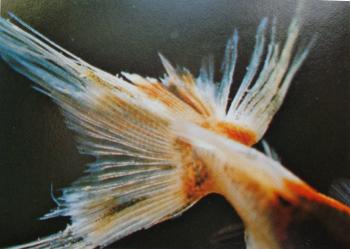| Back to Back Issues Page |
 |
|
The Goldfish Gazette, Issue #081 Treating Injuries September 30, 2020 |
Goldfish Care TipsA Free Monthly Resource For Goldfish Enthusiasts In This Issue Although Goldfish have scales, their body structure underneath is quite delicate. Treating Injuries
Common InjuriesBreeding injuries - The breeding process of Goldfish is quite violent, especially with the single tailed varieties. Loss of scales, split fins, damaged skin patches are all possible.To minimize injury, use soft material for spawning mops or water plants such as water hyacinth that have long delicate root systems ideal for Goldfish to spawn on. Watch for the female being bullied if she isn’t ready to spawn, as the constant rubbing of breeding tubercles against her skin can cause raw inflamed areas. Loss of an eye - This is more common with the telescopic eyed Moor varieties, but it can also happen to normal eyed fish. It is often a mystery what causes a fish to lose an eye, but the most likely causes are being startled and knocking against a hard, sharp object or, another larger fish sucking the eye out. Yes, I have seen it happen, which is why I don’t recommend large size differences in tank mates. Filter injuries - This is more common than I would expect. As long as a filter isn’t excessively large for the aquarium and it has the correct intake grille fitted, there shouldn’t be a problem. The only situation where a filter intake grille may be inadequate is for Water Bubble Eyes. The number of reports on Facebook of burst bubbles caused by the filter intake indicates most power filters need additional protection fitted. Siphon injuries - These injuries are similar to filter injuries but usually much worse. The vacuum created at the hose intake when water is siphoning is usually enough to kill a small fish outright if it is too big to go down the hose, or inflict massive localized injuries to a larger fish. Jumping - If stressed, single tailed varieties will jump, which is another reason why all aquariums should have a lid, and ponds a cover. If a fish is found out of the water, first ensure the gills aren’t sealed shut before returning it to its container. It will still need some preventative treatment to ensure it doesn’t develop an illness caused by its protective slime, skin or scales being damaged. Nets/handling - Always use a net when moving fish, and ensure the net is big enough and the netting material is soft. If you can’t see the fish you are trying to catch because of the water clarity, don’t slash around with the net in the hope you will catch it. Invariably you will end up injuring the fish. Treatment of InjuriesThe Treatment of any of the injuries above is the same three step process.1. Isolate the fish in a hospital tank. An injured fish is like a magnet to other fish in the pond or aquarium. Salt Levels Based on Injury SeverityIf the fish only has some scales missing or torn fins, 1 gram per liter or a teaspoon per gallon is sufficient unless the fish develops fungus or a bacterial condition.If the fish has a more severe injury, add 2 grams per liter or 2 teaspoons per gallon, and observe carefully for signs of fungus or red patches on the skin. If the fish has developed fungus or a bacterial condition before you noticed the injury, add 3-4 grams per liter or one tablespoon per gallon over a 24 hour period. If the fish starts to list over on its side, halve the amount of salt until the fish is stronger.
Comments? Ideas? Feedback? I'd love to hear from you. Just reply to this e-zine and tell me what you think, or what topics you want covered. Next Month's Topic Responsible goldfish breedingwww.facebook.com/aboutgoldfish |
| Back to Back Issues Page |
